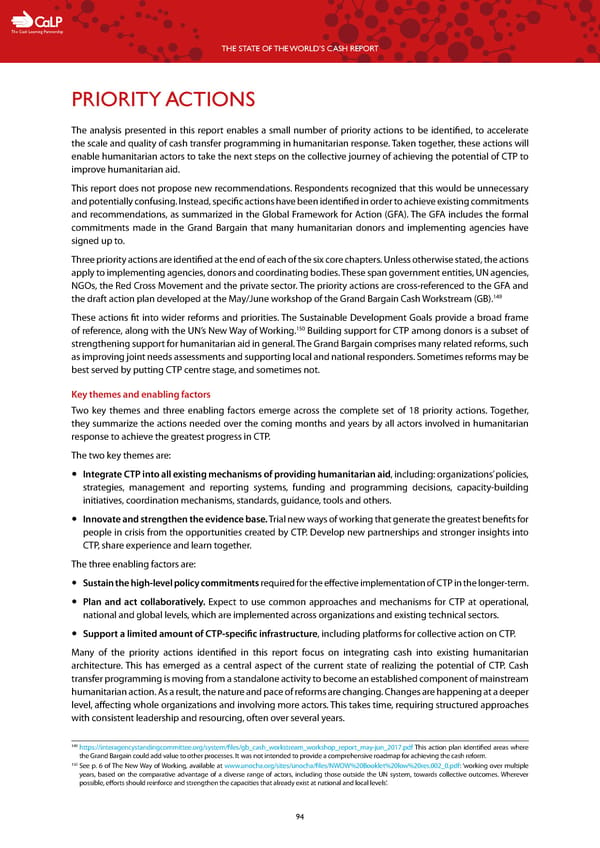C The Cash Learning Partnership THE STATE OF THE WORLD’S CASH REPORT PRIORITY ACTIONS The analysis presented in this report enables a small number of priority actions to be identified, to accelerate the scale and quality of cash transfer programming in humanitarian response. Taken together, these actions will enable humanitarian actors to take the next steps on the collective journey of achieving the potential of CTP to improve humanitarian aid. This report does not propose new recommendations. Respondents recognized that this would be unnecessary and potentially confusing. Instead, specific actions have been identified in order to achieve existing commitments and recommendations, as summarized in the Global Framework for Action (GFA). The GFA includes the formal commitments made in the Grand Bargain that many humanitarian donors and implementing agencies have signed up to. Three priority actions are identified at the end of each of the six core chapters. Unless otherwise stated, the actions apply to implementing agencies, donors and coordinating bodies. These span government entities, UN agencies, NGOs, the Red Cross Movement and the private sector. The priority actions are cross-referenced to the GFA and 149 the draft action plan developed at the May/June workshop of the Grand Bargain Cash Workstream (GB). These actions fit into wider reforms and priorities. The Sustainable Development Goals provide a broad frame 150 of reference, along with the UN’s New Way of Working. Building support for CTP among donors is a subset of strengthening support for humanitarian aid in general. The Grand Bargain comprises many related reforms, such as improving joint needs assessments and supporting local and national responders. Sometimes reforms may be best served by putting CTP centre stage, and sometimes not. Key themes and enabling factors Two key themes and three enabling factors emerge across the complete set of 18 priority actions. Together, they summarize the actions needed over the coming months and years by all actors involved in humanitarian response to achieve the greatest progress in CTP. The two key themes are: — Integrate CTP into all existing mechanisms of providing humanitarian aid, including: organizations’ policies, strategies, management and reporting systems, funding and programming decisions, capacity-building initiatives, coordination mechanisms, standards, guidance, tools and others. — Innovate and strengthen the evidence base. Trial new ways of working that generate the greatest benefits for people in crisis from the opportunities created by CTP. Develop new partnerships and stronger insights into CTP, share experience and learn together. The three enabling factors are: — Sustain the high-level policy commitments required for the effective implementation of CTP in the longer-term. — Plan and act collaboratively. Expect to use common approaches and mechanisms for CTP at operational, national and global levels, which are implemented across organizations and existing technical sectors. — Support a limited amount of CTP-specific infrastructure, including platforms for collective action on CTP. Many of the priority actions identified in this report focus on integrating cash into existing humanitarian architecture. This has emerged as a central aspect of the current state of realizing the potential of CTP. Cash transfer programming is moving from a standalone activity to become an established component of mainstream humanitarian action. As a result, the nature and pace of reforms are changing. Changes are happening at a deeper level, affecting whole organizations and involving more actors. This takes time, requiring structured approaches with consistent leadership and resourcing, often over several years. 149 https://interagencystandingcommittee.org/system/files/gb_cash_workstream_workshop_report_may-jun_2017.pdf This action plan identified areas where the Grand Bargain could add value to other processes. It was not intended to provide a comprehensive roadmap for achieving the cash reform. 150 See p. 6 of The New Way of Working, available at www.unocha.org/sites/unocha/files/NWOW%20Booklet%20low%20res.002_0.pdf: ‘working over multiple years, based on the comparative advantage of a diverse range of actors, including those outside the UN system, towards collective outcomes. Wherever possible, efforts should reinforce and strengthen the capacities that already exist at national and local levels’. 94
 The State of the World's Cash | Full Report Page 95 Page 97
The State of the World's Cash | Full Report Page 95 Page 97